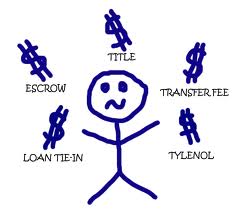How To Handle High Closing Costs
 When you add everything up, closing costs can increase the price of a home by as much as $10,000, sometimes more.
When you add everything up, closing costs can increase the price of a home by as much as $10,000, sometimes more.
Those who are cash-poor can ask relatives for help. But some lenders advertise another option: If borrowers agree to accept a mortgage interest rate from a quarter to a full percentage point higher than they would ordinarily qualify for, they can receive credit toward their closing costs.
Such mortgages are sometimes called no-closing-cost loans, though the term is misleading. The credit usually covers only fees charged by the mortgage broker or bank, like the loan origination fee, the underwriting expense, and the appraisal, according to Neil Diamond, a mortgage broker in Commack, N.Y. That generally leaves title insurance, mortgage-recording taxes, insurance and escrowed taxes to cover, he said.
The amount of credit depends on total closing costs and other loan details. A rule of thumb is that for every one-eighth of a point increase in interest rate, borrowers receive a credit worth half a percentage point of the principal amount, said Jason Auerbach, a divisional manager for First Choice Loan Services in Manhattan. On a $400,000 30-year mortgage with a 4.125 percent base rate, the first one-eighth of a point increase would yield a $2,000 credit and so would the second, but the credit for the third would drop to about $400, he said, noting that some lenders set a 5.25 percent ceiling on rates.
With mortgage rates so low, Mr. Auerbach said, interest in “no-closing-cost” loans has increased. While these mortgages can be helpful to some, borrowers should carefully review all the details. “It’s a sales technique,” Mr. Diamond said. “It can be positive and negative.”
The main downside, of course, is that the higher rate and monthly payment remain in place through the life of the loan. Therefore, Mr. Diamond said, borrowers must ask themselves what they can really afford.
Mr. Diamond suggests doing a side-by-side comparison of loans with and without the credit. If you were paying around $50 a month extra in interest charges to cover, say, $6,000 in closing costs, it would take you 120 months, or 10 years, before you began to pay more in monthly payments than you were saving on closing costs. So if you stayed in the home for seven to eight years — the national average in recent years, according to the National Association of Realtors — you would come out ahead with the higher rate.
But a higher mortgage payment with more going toward interest and less toward principal repayment could lead you to a higher debt-to-income ratio, Mr. Auerbach pointed out. This might affect some borrowers’ ability to qualify for the loan, or might leave them with less money for home improvements or purchases after they moved in.
Even so, a “no-closing-cost” loan can be useful for anyone who has found a home and does not want to wait to save thousands of dollars more to cover all the closing costs. It also can be worthwhile for “people who would rather hold onto their money,” Mr. Diamond said.
Nationwide, total closing costs on a $200,000 mortgage average $4,070, according to a recent survey from Bankrate.com. That represents an 8.8 percent increase over last year, and reflects higher lender fees. New York’s closing costs averaged $6,183, the highest in the nation. In New Jersey the average was $4,589; and in Connecticut, $3,843, according to Bankrate.com.
Closing costs can be much higher on more expensive homes. Dianne Scalza, an associate broker with Netter Real Estate on Long Island, says that buyers in the West Islip area, for instance, typically pay $12,000 to $17,000.
Co-op owners may also benefit from the raise-the-rate approach when it comes to refinancing. Because the loan balance does not change, they most likely will not need board approval for a new mortgage, Mr. Auerbach said.
